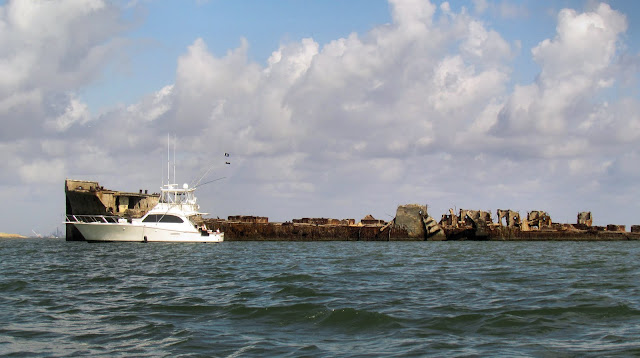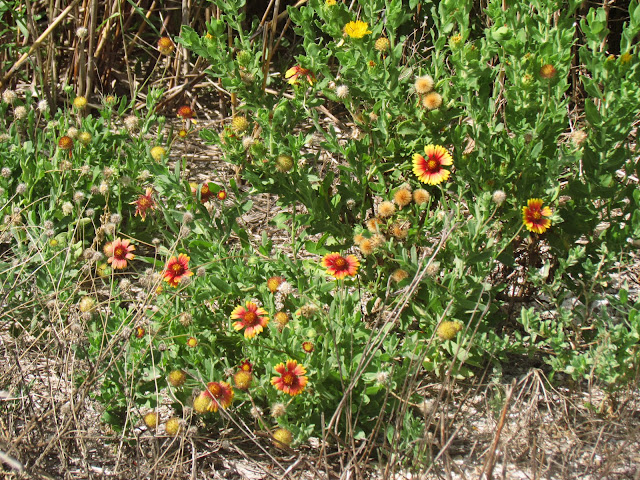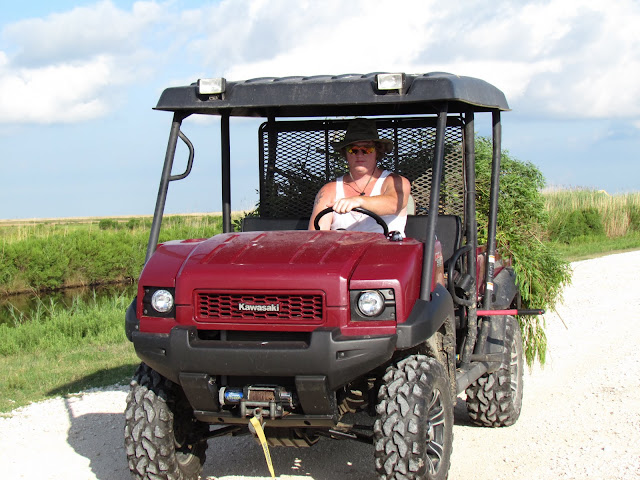Last Thursday, I only worked until noon, then cleaned up and went into Houston for a haircut before starting a wonderful weekend with my friend Natalie. I parked my car at a shopping center and rode back to west Houston with Natalie for a Huston Area Sea Kayakers meeting where John Wharff gave a presentation about his new book,
Kayaking the Texas Coast. Natalie had reviewed the manuscript for the press and also written the review that is on the book cover. I had corresponded with him a few times but neither of us had met him in person.
We enjoyed his presentation, as well as meeting lots of old friends. Our service was really slow - over two hours to get our food - so we didn't get to Natalie's home in Galveston until after midnight. We staggered up early the next morning, cooked a big breakfast, and loaded up kayaks and gear. Then we met a group of people to paddle around Big Pelican Island in Galveston Bay. Texas A & M Galveston is located there and Natalie, the head librarian, got us permission to launch from their beach.
We put in under the training ship for the merchant marine program. Across the bay is a sulfur plant. Sulfur comes in a liquid form on a train, and then is processed into flowers of sulfur which is piled up. You can just see the sulfur color on the right side.
This is the old sailing ship, the Ellissa, which is a kind of museum. The docents used to get to go sailing on her after they earned enough hours. But I hear she is not seaworthy right now. But is is still a fun destination in Galveston. We paddled under a twenty percent chance of rain and saw one little shower in the distance about here. But we were under clouds and looking east so everyone's pictures were very dull.
After we went down to the east side of Big Pelican Island and turned north, we passed
Sea Wolf Park, where the USS Stewart, a destroyer escort, and the Cavella, a submarine are berthed. The actual Sea Wolf submarine was a sister ship to the Cavella but was destroyed at sea.
Soon after we rounded the corner of Sea Wolf Park, we could see the remains of the
Selma, a concrete ship from the WWI era. Now it is a landmark in Galveston Bay and had a pair of American oystercatchers nest on it this spring. Below is a picture taken from closer up.
Just, past the Selma, we stopped for a break. A huge ship was moving in the ship channel and just after we landed and pulled our boats up on the shore, they were hit by the waves from the ship and we had to all grab them and pull them higher.
Natalie and John posed for an authors picture before we left. Natalie will have a book about paddles within an hour's drive of Houston out next year.
And I found some pretty wildflowers on the beach.
On the last leg of our circumnavigation, we were paddling next to the Intercostal Canal and saw lots of ships and tugboats pushing barges. We had to start paddling a little harder because the tide was going out against us. We also got some surfing waves here but I had my non-waterproof camera around my neck so mostly backed off of them. But I did get one good ride.
Little Pelican Island, a bird sanctuary, is just behind this tugboat. It is off limits to people from March to September to allow the birds to nest in peace. Lots of brown pelicans nest there, along with other waders, gulls, and terns. But a few juvenile pelicans were hanging out and fishing on Big Pelican Island, just across from here.
One of the biggest changes to the bay is the container terminal that is currently under construction. Levees are being built to, I guess, provide channels inside for loading and unloading, as well as the docks and maybe storage facilities.So we have to paddle much farther out from Big Pelican Island then we used to and the land looks very different.This may have major impacts on the quality of life in Galveston, as well as on the nesting birds. Already some of the nesting habitat has been destroyed by the construction.
About here, we started catching very strong south winds and our speed dropped dramatically. I had figured we would be all the way back to our landing beach by 12:30 PM but it was almost 1:00 PM before we arrived. But the ten mile paddle was interesting all the way and it was fun to visit with old friends from Houston and Corpus Christi.
I also had good memories of paddling this same trip with Hulin, the former owner of this kayak. He sold it to Natalie who now mostly loans it out to kayak-less friends. I just sold my kayak to a guy in Corpus Christi since I can only haul one boat around with me. Natalie took this picture as we came in to the landing. Behind me is the bridge from Galveston Island to Big Pelican Island.




















 \
\



























